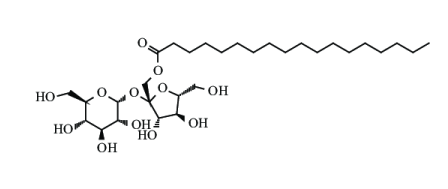Sucrose Stearate Analysis Service | Pharmaceutical Excipient
Sucrose stearate is a class of nonionic surfactants formed by the esterification of sucrose and stearic acid. It usually appears as a white or off-white powder with good emulsifying ability, dispersibility, and biocompatibility. As a pharmaceutical excipient, it is widely applied in oral preparations, topical formulations, and injections, commonly used to improve the solubility and stability of drugs and to enhance their bioavailability. Its analysis mainly relies on advanced analytical techniques to evaluate its purity, thermal stability, component ratio, and structural characteristics.
Sucrose stearate analysis service based on pharmaceutical excipient has application value in multiple fields. In the pharmaceutical industry, it is used for quality control and formulation optimization to ensure the consistency and safety of excipients in drug development and production. In food and nutritional science, it can be used to analyze the content and performance of sucrose stearate to ensure the stability and functionality of food formulations. In addition, in the cosmetics field, it serves as an emulsifier and stabilizer, and its analysis service helps optimize product formulations and evaluate efficacy.

Figure 1. Chemical Structure of Sucrose Stearate.
Services at MtoZ Biolabs
Based on an advanced analytical platform, MtoZ Biolabs has launched the sucrose stearate analysis service based on pharmaceutical excipient which enables comprehensive detection and evaluation of sucrose stearate. This service can systematically analyze its purity, thermal stability, component ratio, and structural characteristics. Through multidimensional detection, researchers can obtain detailed data on sucrose stearate, including molecular structure information, composition ratio, and stability under different conditions, providing reliable support for quality control, formulation development, and functional studies of pharmaceutical excipients. MtoZ Biolabs provides service content mainly including but not limited to the following:
1. High-Performance Liquid Chromatography (HPLC)
Used to detect the purity and component ratio of sucrose stearate, ensuring the accuracy of chemical composition.
2. Mass Spectrometry (MS)
Provides molecular weight and structural feature information for qualitative and quantitative analysis.
3. Ultraviolet-Visible (UV)
Rapidly evaluates the optical properties and stability of the sample.
4. Nuclear Magnetic Resonance (NMR)
Analyzes molecular structure and linkage, confirming the binding characteristics of sucrose and stearic acid groups.
5. Thermal Analysis Techniques (DSC/TGA)
Used to evaluate thermal stability and decomposition characteristics, supporting storage and processing studies.
6. Cell Culture Models
Applied to assess the biocompatibility and functional performance of sucrose stearate as a pharmaceutical excipient.
Sample Submission Suggestions
1. Sample Type
Applicable to pharmaceutical excipient samples containing sucrose stearate, which may be in the form of powder, granules, or solution. The source of the sample must be clearly identified, and the composition must be intact.
2. Sample Purity
It is recommended to remove other impurities as much as possible, such as proteins, lipids, or unrelated additives, to minimize interference with the analysis results and improve the accuracy and reliability of detection.
3. Sample Storage and Transportation
Samples should be stored under dry, light-protected, and low-temperature conditions. During transportation, powder samples should be sealed to prevent moisture absorption, while liquid samples can be transported with ice packs to ensure sample stability.
Service Advantages
1. High-precision Detection
Relying on advanced analytical platforms, accurately evaluate the purity, composition ratio, and structural characteristics of sucrose stearate.
2. One-Time-Charge
Our pricing is transparent, no hidden fees or additional costs.
3. Customized Solutions
According to the client’s research objectives and sample types, provide tailored analytical strategies to flexibly meet different research and development needs.
4. One-stop Service
Covering the complete process from sample preparation, testing and analysis to data interpretation and report generation, ensuring efficient and reliable experiments.
Applications
1. Pharmaceutical Formulation Development
Sucrose stearate analysis service can be used to evaluate its stability and functionality in tablets, capsules, and oral liquids, ensuring sustained-release, controlled-release, and taste-masking effects.
2. Quality Control and Compliance Testing
By analyzing the purity, thermal stability, and composition ratio of sucrose stearate, its consistency and compliance in pharmaceutical production can be ensured.
3. Excipient Optimization Research
Sucrose stearate analysis service can be applied to explore the compatibility of sucrose stearate with other excipients or active ingredients, supporting drug formulation optimization and performance improvement.
4. Food and Nutrition Product Development
In functional foods and nutritional supplements, it can be used to evaluate its application value as an emulsifier or stabilizer, ensuring product quality and standardization.
FAQ
Q1: Why Is It Necessary to Analyze Sucrose Stearate?
A1: As a commonly used pharmaceutical excipient, the purity, composition ratio, and thermal stability of sucrose stearate directly affect the quality and consistency of pharmaceutical formulations. Systematic analysis ensures its stability and reliability across different batches and applications.
Q2: Can Low Levels of Sucrose Stearate Be Detected?
A2: Yes. With the support of techniques such as high-performance liquid chromatography (HPLC), mass spectrometry (MS), and nuclear magnetic resonance (NMR), even low-abundance components can be accurately detected and quantified.
How to order?







